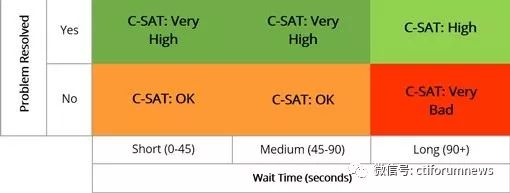

This is because people may have dialed the wrong number in error and then hung up. This can be set on many ACD systems.
This is usually considered okay.
Experienced resource planner Dave Appleby said, “The duration of these calls is not even as long as a ringing cycle. Some ACDs may not even send it to the queue, even if the customer hears it ring.â€
Therefore, excluding short-term abandonments, the revised formula becomes:


The above table is taken from our article: “Is there a correlation between queue time and customer satisfaction?†It shows that as long as the call problem is resolved, the queue time does not significantly affect customer satisfaction.
While this is a good example, not counting time-based metrics, computing service levels remains an essential part of many contact center workforce management (WFM) strategies. How do people manipulate service levels? As with any metric, once people see an indicator that matters, they start to manipulate the results. Here are three common ways service levels are manipulated: 1. **Excluding abandoned calls** – One of the easiest ways is to exclude the number of abandoned calls from the calculation. For example, Cisco Contact Center software allows for three different methods of computing service levels. Abandoned calls can negatively, neutrally, or positively affect the service level, depending on how the system is configured. 2. **Changing the goal temporarily** – Some supervisors change the service level goals mid-cycle to make the results look better. For example, a supervisor might switch from 90% within 15 seconds to 80% within 20 seconds, making it easier to meet the target. 3. **Using a phone screening team** – Some companies create a telephone screening or classification team, similar to an enterprise switch, which answers calls quickly before transferring them to the appropriate department. While this doesn’t speed up resolution, it can make service level metrics look better. In the past, regulators in the UK required companies to answer 90% of calls within 30 seconds. However, some companies found ways to circumvent this by using screening teams. As a result, in 2005, regulators replaced the single service level measurement with a broader set of metrics to provide a more comprehensive view of telephone processing.Introducing the reliable and efficient LiFePO4 Cell, with a nominal voltage of 3.2V, perfect for powering your devices and equipment with ease. These cells are designed with advanced technology, ensuring a stable and consistent power supply to your devices. The Lithium Iron Phosphate (LiFePO4) chemistry used in these cells makes it the perfect choice for high-performance applications. These cells have excellent discharge characteristics and a long life cycle, making them a cost-effective and eco-friendly option.
Lifepo4 Cell,Lifepo4 Battery,Lithium Iron Battery,Cylindrical Lifepo4 Battery
JIANGMEN RONDA LITHIUM BATTERY CO., LTD. , https://www.ronda-battery.com
